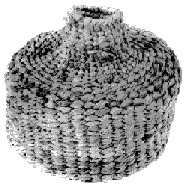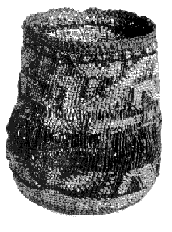
Cornhusk Bottles and Baskets
tobacco bottle ~ Seneca
[Turnbaugh & Turnbaugh 1986]

|
Cornhusk Bottles and Baskets |
| Twined cornhusk salt or tobacco bottle ~ Seneca [Turnbaugh & Turnbaugh 1986] |

|
|
Twined cornhusk, wool and basswood basket ~ Narragansett. [Turnbaugh & Turnbaugh 1986]. |
In the fall, the Iroquois and other Native American women harvested corn from their gardens. To prepare the corn for storage, the husks were folded back from the ears and braiding, forming long ropes of husk with dangling ears of corn. The corn could be hung by these ropes to dry and later prepared for storage in baskets or earthen pits. The cornhusks were then used for many purposes, for cordage, for wrappers to cook food, for fire tinder, for stuffing mattresses or cushions, and for many woven items including mats, masks, shoes and baskets. Braiding, coiling, sewing and twining were some of the methods used to weave objects from cornhusks.
Twined cornhusk baskets are made by many
eastern Woodland Native Americans, including the Iroquois. One
such basket, called 'Ganoseha', was made to contain
coarse corn meal. This basket is constructed of cornhusks and
blue flag leaves. Cornhusks are used for the warp, or ribs, of
the basket, the bottom of the basket is made using cornhusk weft,
and the top uses weft of blue flag. Although blue flag leaves
are not as durable as cornhusks, they are longer and don't require
as much splicing together when the basket is formed.

|
|
Cornhusk bottles for salt ~ Iroquois. [Tooker 1994]. |

|
|
Cornhusk bottle reproduction [by Prindle 1999]. |
Another type of twined cornhusk basket
was water tight. This basket was used historically to store salt.
The Iroquois word for this basket is 'Gushada', which
translates as into English as 'bottle'. These twined bottles
sometimes combined flag leaves in the weaving. A stopper made
from a corn cob was used to keep these bottles sealed.
Traditionally, one type of Cayuga cornhusk
basket is meant to contain tobacco. The basket and the tobacco
kept inside are used for an offering during the Thunder Rite and
Ball Game, one of the ceremonies performed by the Cayuga unrestricted
societies. This one day ceremony is performed during the summer
to honor the Seven Thunders, or Grandfathers. The Cayuga are thankful
for what the Thunders do as envoys of the Great Spirit. The Thunder
rite is performed to ask these Grandfathers to continue to carry
out the desires of the Great Spirit which benefit people.

|
|
Cornhusk basket for burn tobacco offering ~ Iroquois. [Speck 1949]. |
The main part of this ceremony consists
of the Ball Game. This traditional Ball Game, also called Lacrosse,
has survived the centuries and is still played, both in ceremony,
and as a 'modern' sport, by both Native and nonNatives.
The game is called 'Gatcikwae' (beating the mush) and is
played between the younger and older men, often from opposing
clans. The playing course consists of a large space between two
sets of goals (posts set 7 feet apart), and the team to first
score seven points wins the game.
Before the Ball Game is played, the players
and participants gather at the edge of the course where they ingest
a medicine, an emetic, which purifies their bodies. A fire is
also built outside the Long House for the ceremony, where the
leader offers prayers to the Seven Thunders. It is accompanying
these prayers to the Thunders that the cornhusk basket containing
tobacco is placed in the fire and consumed by flames. A Cayuga
explained that the cornhusk basket is given to the Grandfather
Thunder to keep his tobacco while he travels. The players of
the game are instructed to play fairly and to compete in good
faith.

|
|
Cornhusk basket ~ Iroquois. [Lyford 1945}. |
It is really of no consequence to the
players or to the spectator who wins the game. Following the
game, the players sing the Thunder song and dance their way back
to the Long House, where additional songs and thanks are offered,
and tobacco and corn mush are given to the Ball Game players.
Often other people bring gifts to the Long House, and these gifts
are also distributed amongst the players, accompanied by prayers
for the players and for those that brought the gifts. The ceremony,
including episodes of songs and dancing, and then gift giving,
continues until all the offerings have been given away.

|
Text and Graphics
© 1994 - Tara Prindle unless otherwise cited. |